Browser-based errors are often rare, and when they pop up, you can quickly determine the cause. For example, 404 errors, 502 bad gateway errors, and more all have specific fixes or causes. The PR_END_OF_FILE_ERROR isn’t one you’ll see on a regular basis, but it’s frustrating when you do, and it’ll need your immediate attention.
If you’re a Safari or Chromium-variant user, this error won’t affect you. It’s a Firefox-only issue that has a few different fixes. There’s no deep technical knowledge required, though, and you’ll have all of the tools and skills you need to resolve the error.
For this article, we’re going to look at everything to do with the PR_END_OF_FILE_ERROR. We’ll show you how to fix it and avoid it in the future.
First, though, we’re going to explain what the error is and how it’s caused.
Check out our video guide to fixing the PR_END_OF_FILE_ERROR:
What is the PR_END_OF_FILE_ERROR?
The PR_END_OF_FILE_ERROR is a secure connection issue. It’s a Firefox-specific error that happens when the browser can’t establish a secure connection with the website. Therefore, it is a problem on the client-side.
To go a little deeper into the details of this definition, we have to talk about “cipher suites.” This can get complex, but in a broad sense, it’s a list of instructions to help secure and authenticate a network connection over an encrypted protocol.
If a connection uses Secure Sockets Layers (SSL) or Transport Layer Security (TLS), the browser will look to connect by running down the list of cipher suites. Once it finds a match, the connection is made, and the user can continue. If not, you’ll get a secure connection error.
In a nutshell, the error tells you that the browser has run through its list of cipher suites and doesn’t have a match. In a literal sense, it has reached the end of the cipher suite file and returned nothing.

The PR_END_OF_FILE_ERROR only happens on Mozilla Firefox, which means you won’t see this in Safari, Chrome, Brave, or Edge. It will often affect every website you try to navigate to. Our research didn’t uncover any explicit reason for why this is, but you’ll get more of an idea of the causes in later sections.
This is a secure connection issue, but it’s not the same as those you’ll see in other browsers. Here, the problem lies with third-party software or a browser configuration issue rather than inherent security.
| Error Code | PR_END_OF_FILE_ERROR |
| Error Type | Browser error |
| Error Variations | Secure Connection Failed |
| Error Causes | Incorrect or corrupted Firefox profile Incorrect ciphers Misconfigured VPN or proxy Third-party security software interference |
What Causes the PR_END_OF_FILE_ERROR?
For an issue that involves a few different moving (and encrypted) parts, the causes for the PR_END_OF_FILE_ERROR are often straightforward. In fact, there are four reasons for the error to appear:
- An incorrect or corrupt browser profile. This is a common cause for the error and could be the reason why it’s Firefox-specific.
- Incorrect ciphers. It could be that the ciphers themselves are incorrect, which means you’ll need to import the right ones.
- Misconfigured proxy or Virtual Private Network (VPN) connections. If your connection seems ambiguous with regard to your location, this can sometimes cause the error.
- Third-party security software interference. This is a classic reason for many errors and issues on a computer and will affect Windows machines much more than Mac.
For the most part, the specific causes aren’t too technical (although they may seem that way at first glance). Throughout this article, we’ll show you how to fix the PR_END_OF_FILE_ERROR and re-enable your ability to browse the web.
How To Fix the PR_END_OF_FILE_ERROR?
There are five distinct fixes for the PR_END_OF_FILE_ERROR. We’ll discuss them below. Note that we’re not going to present them in any particular order because any or all of these causes could be at fault.
As such, dip into a solution that matches your specific problem and what you already know. If that doesn’t work, take a look at the other solutions to resolve the error.
1. Disable Your Third-Party Security Software
One of the big differences between Windows and Mac machines is the reliance on security and antivirus software. Both Linux and macOS have an infrastructure that means these types of programs aren’t necessary to browse the web in safety.
As such, this first fix will apply mostly to Windows Firefox users. The concept is that your security and antivirus see the cipher suites as a potential threat. Taking this software out of the equation means you can test the connection without interference.
While there are too many available solutions to give specific details on here, there will be a similar process for all software:
- Access the dashboard for your solution and toggle it off. In lots of cases, there will be a marked button or switch for doing so.
- Once you’ve done this, exit out of the program and reboot your computer. We recommend you shut down, wait 30 seconds, then restart. This gives your computer’s memory time to clear.
- Check that the software isn’t running again when you’re back onto your desktop, as this can happen on startup.
- Check your browser and see if the error persists.
If not, you’re good to go about your browsing as before. If you still see the PR_END_OF_FILE_ERROR, though, you’ll want to look at the next few fixes.
2. Disable Your VPN or Proxy
Much like your security and antivirus software, your VPN and proxy settings could also have an impact on your browser. The reasons for this are similar to the previous section: the inherent functionality involved can “block” connections and cause your browser to think cipher suites don’t exist.
The good news is that you would disable your VPN the same way as your antivirus — it should be a one-click process. From there, reboot again and check your connection in-browser.
The process to disable your proxy is more involved but still achievable. For Mac users, first, open System Preferences > Network.
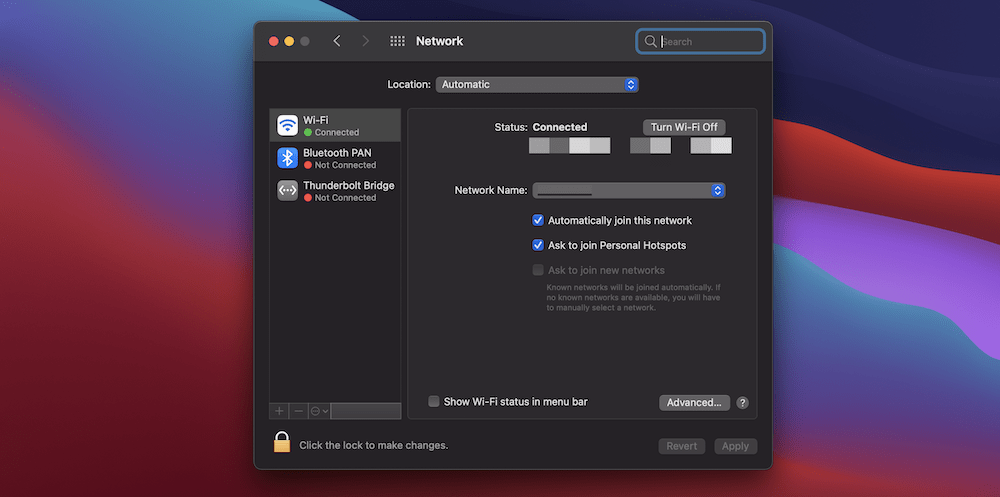
If you need to click the “lock” icon to make changes, do so here.
Select the network service you use (likely Wi-Fi in most cases) when you’re ready, then click the Advanced button. On the next screen, open the Proxies tab:
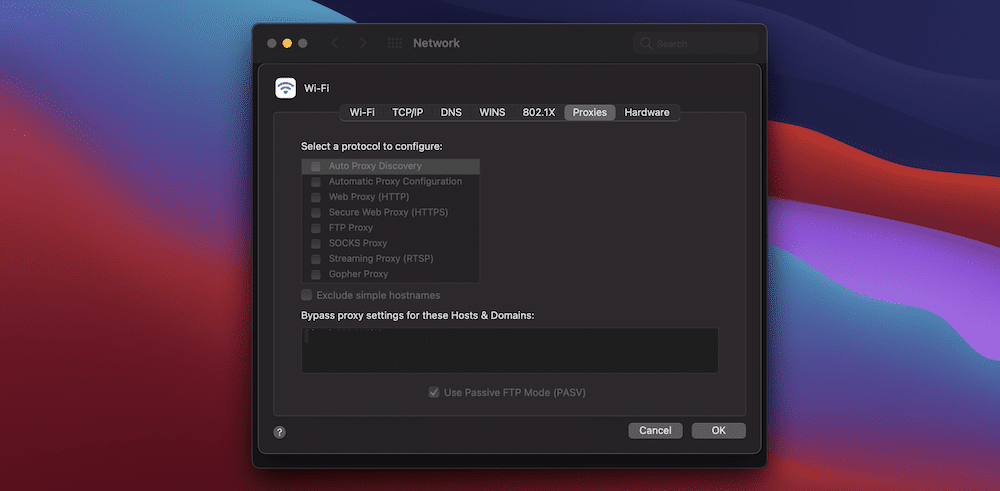
In our example, we have no proxies configured or selected. In your case, you may see some of the options checked. Your task here is to uncheck them, click OK, reboot your computer, then test your connection.
For Windows users, disabling your proxy server is just as straightforward. First, type “Proxy” into the search bar, and open the shortcut to the proxy settings:
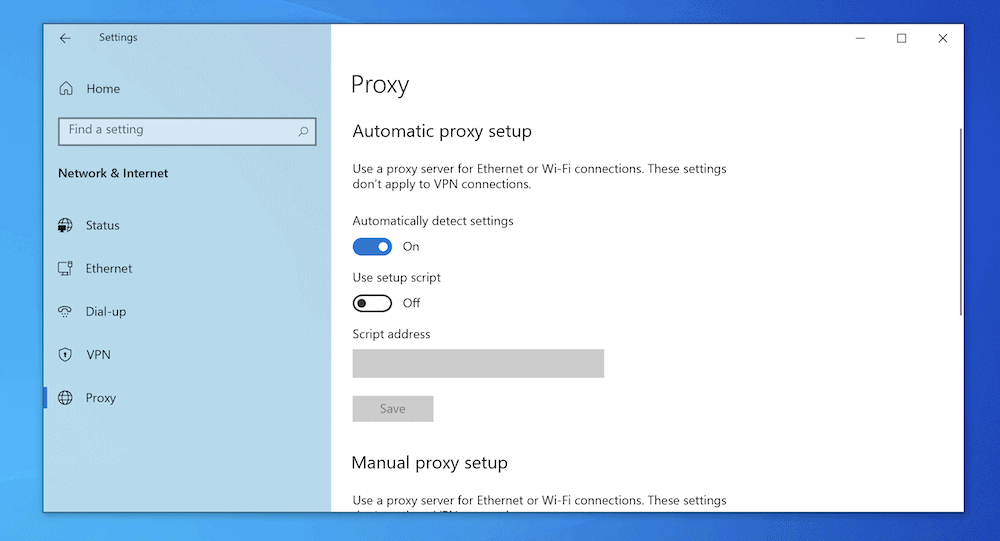
From here, scroll down to the Manual proxy setup section, and toggle the Use a proxy server switch to Off:
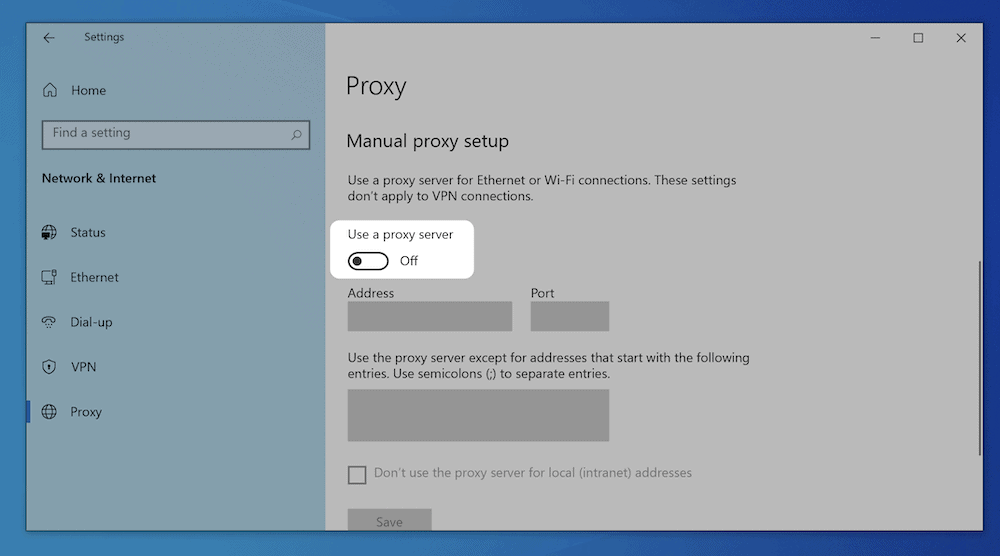
As with the other methods, reboot your computer again and try to navigate to a page. If you still have the PR_END_OF_FILE_ERROR, you may need to dig into your browser’s settings.
3. Reset Firefox’s Secure Sockets Layer (SSL) Settings
Your first instinct might be to skip over this solution, especially if you haven’t touched your browser’s SSL settings. However, it’s still worth going through this fix because it’s quick to accomplish and could resolve your issues without further work.
To reset your SSL settings, head to the “hamburger” menu within Firefox and click the Help option:
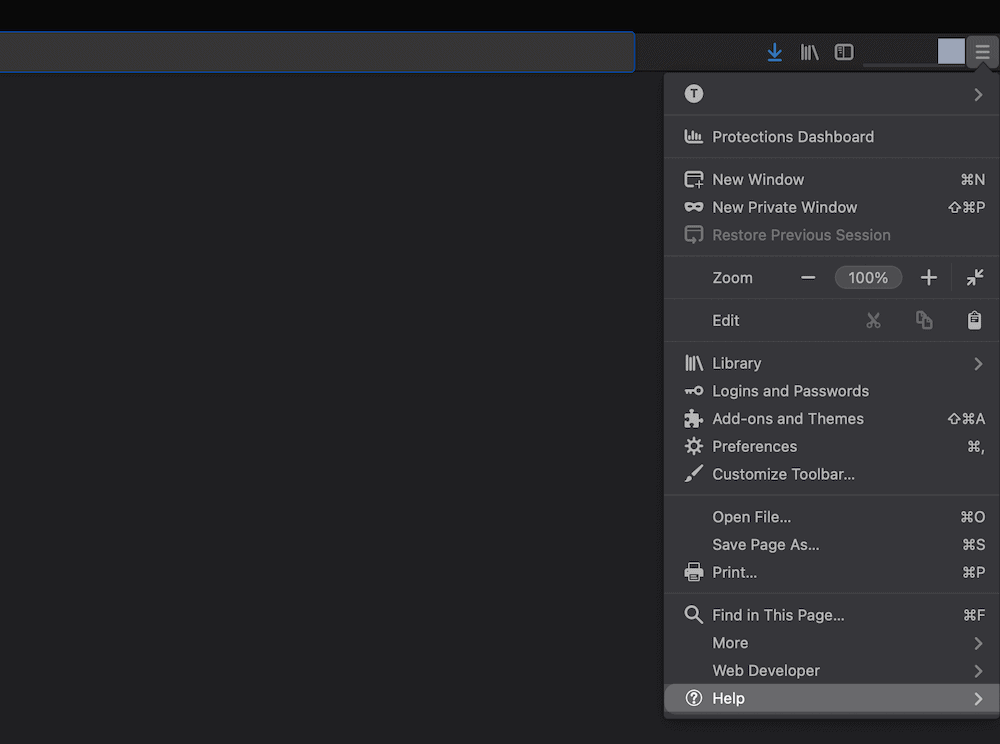
From here, select More Troubleshooting Information. This will pop a screen up in-browser showing some diagnostics:

Here, click the Refresh Firefox button, and your browser will restart. This is enough to reset your SSL settings, so check out whether you can browse the web at this point. If not, there is another technical fix we can carry out.
4. Disable the Domain Name System (DNS) Over HTTPS Within Firefox
In short, your DNS is how you can browse the web using URLs such as kinsta.com. DNS over HTTPS is a protocol for these DNS requests through HTTPS.
The goal of the protocol is to stop machine-in-the-middle attacks and prevent malicious “eavesdropping,” but this normally helpful feature of Firefox can also cause the PR_END_OF_FILE_ERROR.
The solution is to disable it. To do this, head to your Firefox Preferences screen. This is through the hamburger menu within the browser, or you could use the toolbar instead:
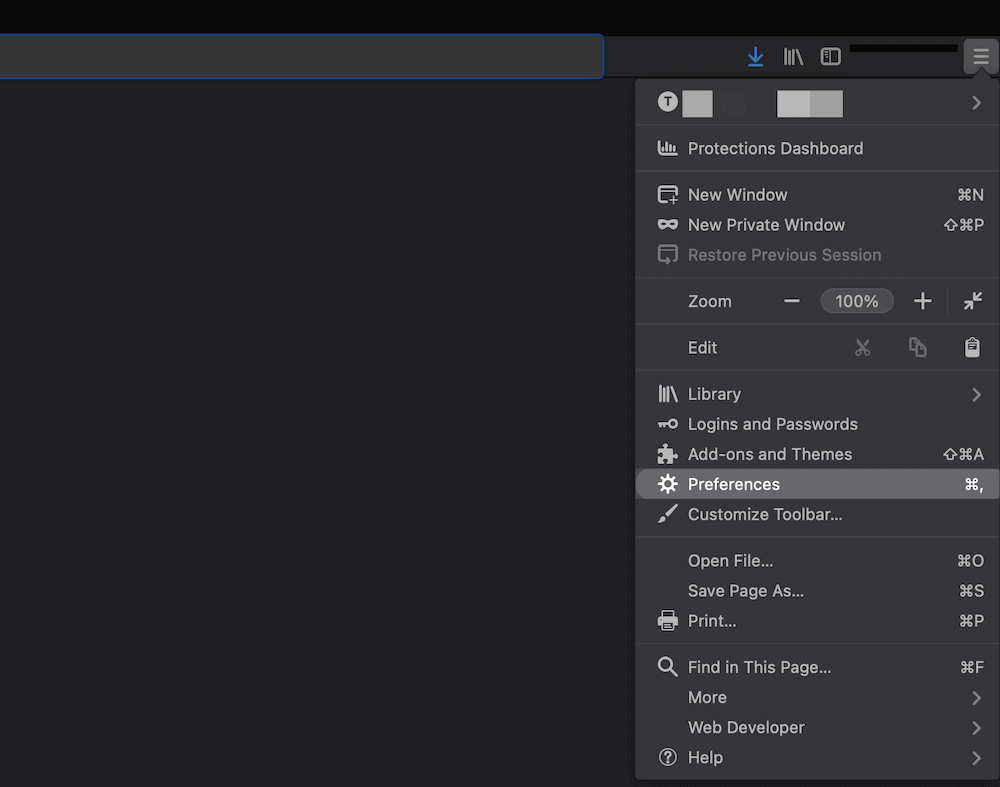
From here, make sure you’re on the General screen:
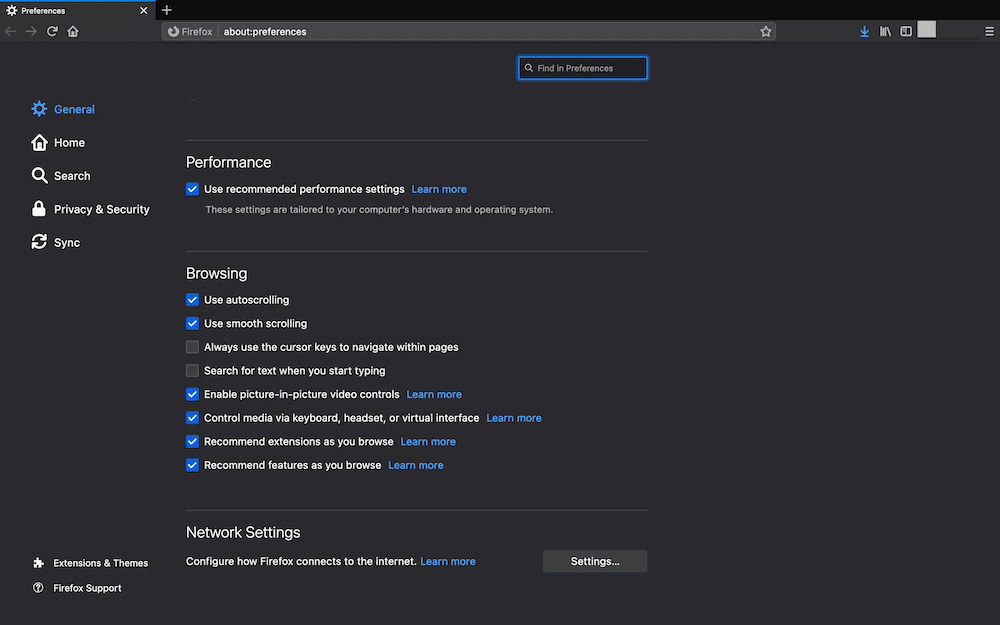
If you scroll down to the Network Settings section and click the Settings… button, you’ll open the Connection Settings:

From here, find the Enable DNS over HTTPS option, and uncheck the box. Once you restart Firefox, check your browser and see if the error has gone.
5. Create a New Firefox Profile
At this point, you will have run through most of the fixes for the PR_END_OF_FILE_ERROR. If you still have no luck resolving it, rebuilding your Firefox browser profile should get you back up and running.
Before you do this, it’s a good idea to save your bookmarks. You can access the bookmark library in a few ways — you can use the Library button in the toolbar, utilize a keyboard shortcut, or click the Bookmarks > Show All Bookmarks in the menu bar:
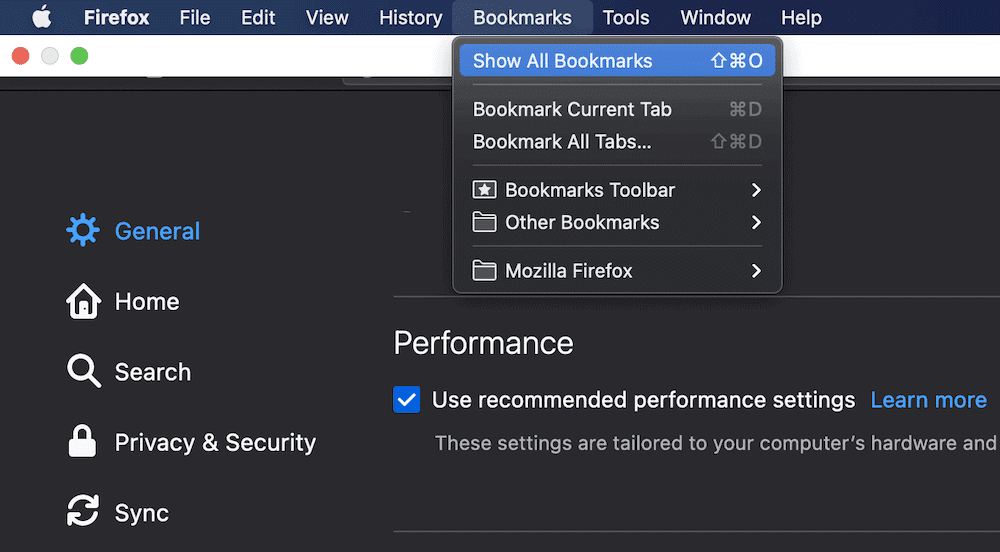
Here, select the All Bookmarks option from the tree explorer, and choose the Import and Export option at the top. It looks like two arrows pointing in opposite directions:

Click Export Bookmarks to HTML…, and save the file somewhere you can reach it again. From here, open the Profile Manager by typing “about:profiles” into the Firefox browser bar and clicking Enter. This will bring up a screen showing your current list of profiles and a button to create a new one:
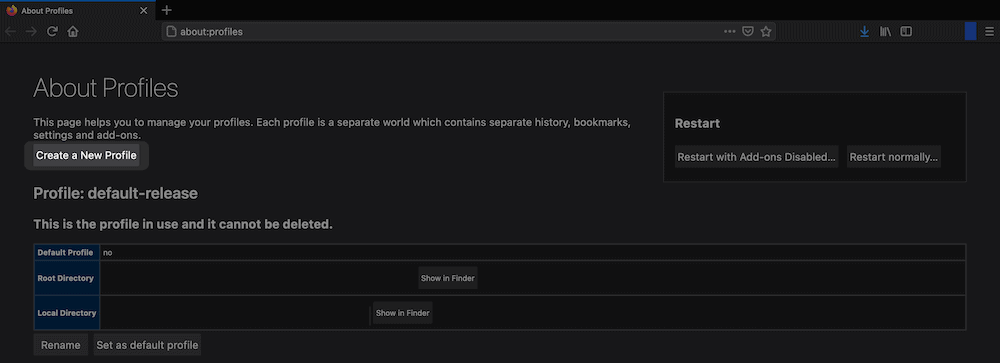
If you click this button, you can enter a new user name. Once you confirm, this new user will show at the bottom of the Profile Manager:

At this point, click Launch profile in new browser, and the PR_END_OF_FILE_ERROR should disappear. You’ll also want to import your bookmarks, following our advice from earlier on. It’s the same process, but this time you’ll choose Import Bookmarks From HTML….
How To Avoid the PR_END_OF_FILE_ERROR?
In the future, you’ll want to make sure the PR_END_OF_FILE_ERROR won’t return. To do this, you should consider the following:
- Determine whether your third-party security or antivirus software is actually needed. At the same time, consider whether you need a new solution (or new settings) that won’t cause the error again. You might also want to check your VPN solution for the same reasons.
- Take a look at your proxy settings to see if a change is necessary. If you’re causing an issue here, there may be other areas that your proxy is affecting.
- Your SSL settings are often set in an optimal way. As such, tinkering with them if you’re not an expert could spell disaster.
It could be that you’ll see the PR_END_OF_FILE_ERROR again regardless of your preventative measures. As such, having the knowledge on hand is going to serve you well alongside taking precautions.
Summary
Browser errors are few and far between and often are straightforward to diagnose and fix. That said, the PR_END_OF_FILE_ERROR is a strange one because it’s Firefox-specific and rare.
Even so, you can fix the issue without digging too deep into your technical knowledge. The first port of call is to disable any security or antivirus software. From there, you can check and reset any SSL or DNS settings and — if all else fails — rebuild your Firefox browser profile.
While we’re known for stellar uptime and rock-solid stability, our support team is on hand round-the-clock to help you with website or hosting issues. Kinsta customers can contact us through the MyKinsta dashboard and be back up and running in no time!


